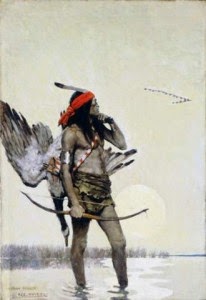 |
| The Halve Maen Passing Hudson Highlands, by little old me. |
If you want to see The Halve Maen Passing Hudson Highlands, above, you’ll need to get out to RIT-Dyer this month, because the painting is sold and will be shipped after Intersections of Form, Color, Time and Space closes.
I painted this for the 400th anniversary of Hudson’s voyage of exploration. From the native perspective, the boat is a black spot of melanoma, or the first eruption of the plague—something seemingly insignificant that will forever change the world. The brilliant colors are those of a dying day, a flaming sunset, the end of a season.
I love history but generally shy away from historical paintings. They have great potential to be pedantic. You must study the dress, weaponry, housing, jewelry, and landscape of the period, and then you must edit the regalia down to the point where it no longer drives the painting. The Lenape people, fortunately, are well-documented anthropologically and artistically, including in N.C. Wyeth’s The Hunter (1906).
 |
| Stu Chait and me at the opening of Intersections of Form, Color, Time and Space.
My Dying Boudicca is on the left; his Atemito is on the right.
|
I have another historical painting in this show, Dying Boudicca (on the left, above). Boudicca was queen of the Icenis, and led the most successful uprising ever against the Roman Empire. She was married to a client king of the Romans. He was deeply in debt to Roman lenders at the time of his death. He left his kingdom jointly to his daughters and the Emperor, but on his death his kingdom was annexed as if conquered.
 |
| The Hunter, by N.C. Wyeth, accurately depicts pre-contact Lenape work togs. Wyeth trod the narrow line between historical accuracy and gripping painting with unerring taste. |
Boudicca was beaten, her daughters were raped, and Roman financiers collected the swag. Boudicca rallied her people and the neighboring Trinovantes. They destroyed Colchester, London and St. Albans. Casualties among the Romans were estimated to be between 70,000 and 80,000 people. Of course the Britons were destined to eventually fail against such superior numbers. Rather than submit to capture and humiliation, Boudicca poisoned herself.
In my painting, Boudicca’s pomp and circumstance, represented by her purple robe, is discarded. At the moment of her death, she is a woman alone.
I’m leaving for Maine next week. Come join me! I’m down to one opening in my 2014 workshop in Belfast, ME. Information is available here.





















